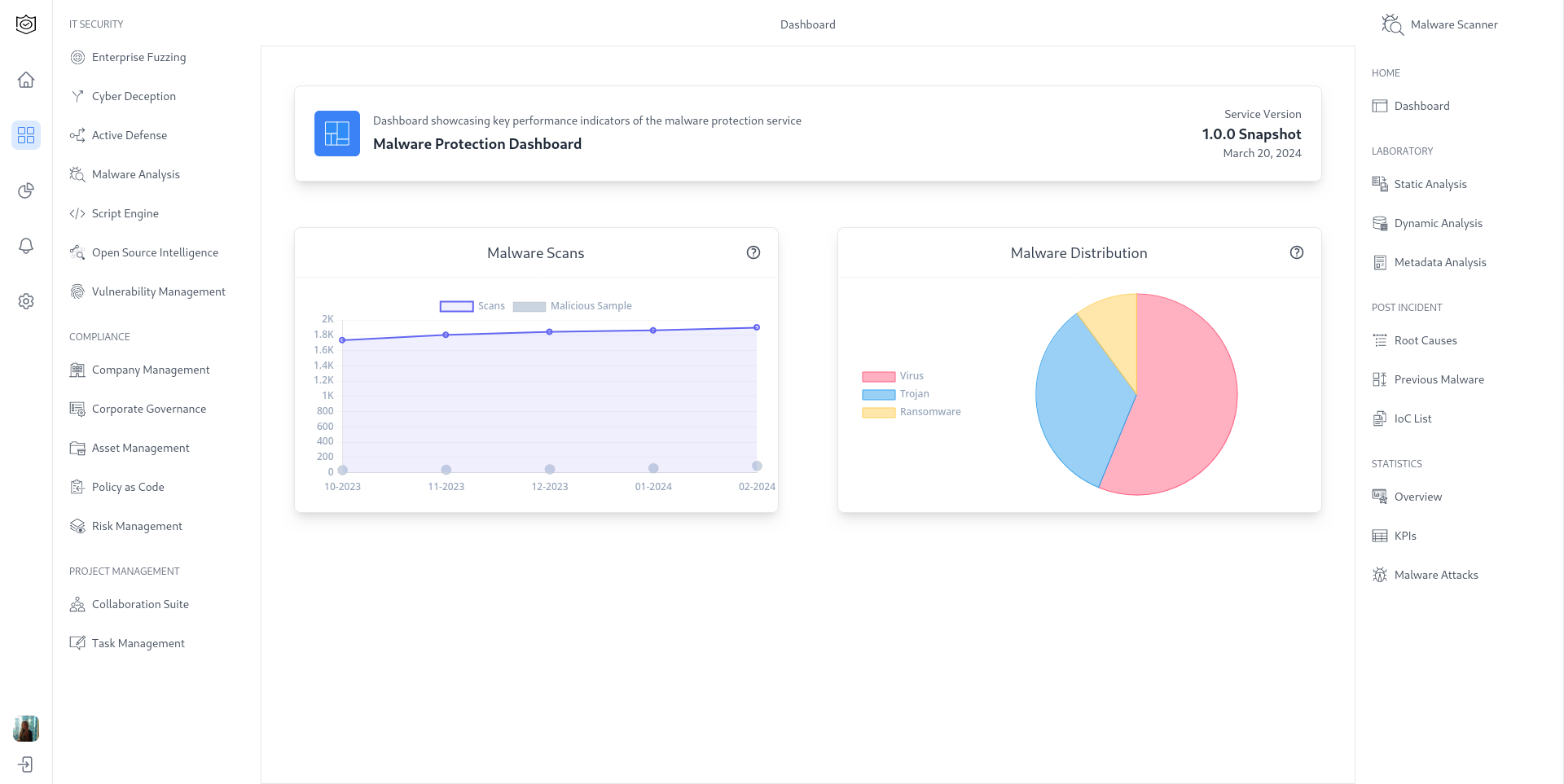1. CypSec’s Malware Detection Service
As cyber threats evolve, malware continues to be one of the most pervasive and dangerous tools in an attacker’s arsenal. CypSec’s malware detection service offers organizations a robust solution for identifying and mitigating malicious software across their infrastructure. Through a combination of static analysis, heuristic evaluation, and integration with the broader CypSec ecosystem, this service provides real-time detection, helping organizations prevent, analyze, and respond to malware threats effectively.
Key Benefits
- Real-Time Detection: Detect and quarantine malware in real-time, minimizing the risk of infection and damage.
- Advanced Analysis: Leverage static, heuristic, and behavioral analysis to detect both known and zero-day malware.
- Automated Response: Integrate malware detection with active defense for instant response and mitigation.
- Compliance Support: Meet regulatory requirements with detailed forensic reports, automated detection, and quarantine processes.
- Seamless Integration: Connect with CypSec’s threat intelligence, vulnerability management, and incident response services for a holistic approach to security.

2. Core Features
Static Malware Analysis
CypSec’s malware detection service uses static analysis to inspect files, binaries, and executables before they are executed. This method allows for a thorough examination of the file’s structure, metadata, and embedded code to identify potential malicious indicators. By scanning files for known malware signatures, suspicious behaviors, and structural anomalies, the system detects threats before they are activated, reducing the risk of infection across your network.
Heuristic and Behavioral Analysis
To enhance its detection capabilities, CypSec’s malware detection service incorporates heuristic analysis. This method evaluates the behavior and characteristics of files to identify unknown or zero-day malware, even if it doesn’t match a known signature. By simulating file execution in a controlled environment, the platform observes how the file behaves, flagging anything that exhibits suspicious patterns like privilege escalation, abnormal network traffic, or unauthorized file modifications.
3. Advanced Detection Techniques
AI-Powered Threat Identification
Leveraging machine learning algorithms, CypSec’s malware detection service continuously improves its ability to detect sophisticated malware. The system is designed to learn from historical threat data, adapting to new attack vectors and identifying complex malware variants. This AI-driven approach enables the platform to detect previously unseen malware strains, providing organizations with enhanced protection against evolving threats.
Sandboxing and Isolation
For more in-depth analysis, the service uses sandboxing techniques, executing potentially malicious files in a secure, isolated environment to observe their behavior. The sandbox environment mimics the target system, allowing the malware to execute without causing real harm. This gives security teams detailed insights into how the malware operates, what actions it takes, and what damage it could potentially cause. The system automatically quarantines suspicious files to prevent them from spreading, while providing a comprehensive report for further investigation.
4. Seamless Integration and Automation
Integration with Active Defense
CypSec’s malware detection service integrates seamlessly with the broader active defense framework, enabling automated responses to malware threats. Once detected, malware is automatically flagged and isolated, and a series of automated defense actions are triggered to contain the threat. This integration ensures that malware detection is part of a comprehensive security strategy, offering real-time response capabilities to stop malware in its tracks.
Threat Intelligence Integration
The service is powered by real-time threat intelligence, cross-referencing malware signatures, threat reports, and global attack patterns. By connecting with CypSec’s threat intelligence platform, the system ensures that it remains up-to-date with the latest malware strains and tactics used by attackers worldwide. This intelligence-driven approach boosts detection accuracy and enables organizations to stay one step ahead of emerging malware threats.
5. Comprehensive Malware Analysis
Malware Family Classification
CypSec’s malware detection service not only identifies malware but also classifies it into known malware families. Whether it’s ransomware, spyware, Trojans, or rootkits, the system provides detailed information about the specific type of malware, its typical behavior, and the potential impact it can have on your organization. This classification enables security teams to prioritize their response efforts and apply the most effective remediation strategies for each type of threat.
Detailed Forensic Reports
Once a threat is detected, the system generates forensic reports that include comprehensive details about the malware’s behavior, origin, and potential targets within the organization. These reports are invaluable for incident response teams, helping them understand the scope of the attack and plan the next steps in mitigation. The service also logs all malware-related activity, providing an audit trail that is crucial for compliance and post-incident reviews.
6. Security and Compliance
Regulatory Compliance
Organizations are required to comply with stringent data protection laws and industry regulations, such as GDPR, ISO 27001, and NIS2, which mandate robust cybersecurity measures. CypSec’s malware detection service supports organizations in meeting these requirements by providing automated malware detection, quarantine processes, and forensic reporting. By ensuring that malware threats are detected and handled promptly, the service helps businesses maintain compliance with regulatory frameworks.
Real-Time Quarantine and Response
The malware detection service is designed to stop malware at the point of detection. Once malware is flagged, it is automatically quarantined to prevent it from spreading within the system. This immediate response capability is critical in reducing the potential damage caused by malware infections. Security teams are notified in real time, allowing them to initiate further investigation and remediation actions without delay.
7. Interconnected Ecosystem
Integration with Vulnerability Management
CypSec’s malware detection service works in tandem with the vulnerability management platform, identifying malware that targets specific vulnerabilities within an organization’s infrastructure. By correlating detected malware with existing vulnerabilities, the platform provides deeper insights into attack vectors and potential points of exploitation. This integrated approach ensures that organizations not only detect malware but also address the underlying vulnerabilities that made them susceptible to the attack in the first place.
Collaboration with Incident Response
The service’s integration with CypSec’s incident response tools ensures that any detected malware is promptly addressed by the appropriate teams. By providing automated reports and detailed information about the malware’s actions, the system streamlines the incident response process. Teams can quickly assess the severity of the threat, determine the affected systems, and take action to mitigate the impact. This collaboration between malware detection and incident response enhances the organization’s ability to recover from malware incidents swiftly.
8. Customization and Scalability
Tailored Detection Rules
Every organization faces unique threats, and CypSec’s malware detection service allows administrators to create custom detection rules based on their specific needs. Whether it’s monitoring specific files, processes, or network traffic patterns, the service is fully customizable to adapt to the organization’s threat landscape. These tailored rules ensure that the platform can detect even the most targeted malware campaigns designed to evade standard detection methods.
Scalable for Enterprise Environments
Whether your organization operates a small network or a complex global infrastructure, CypSec’s malware detection service is designed to scale. The platform can handle high volumes of traffic and files, ensuring that all assets are covered, regardless of size or complexity. As your business grows, the service can be easily expanded to protect new assets, ensuring that every part of your digital environment remains secure.
9. Conclusion
CypSec’s malware detection service provides organizations with an essential layer of defense against one of the most prevalent cyber threats: malware. Through a combination of static analysis, heuristic evaluation, and sandboxing techniques, the service ensures that malware is detected, analyzed, and quarantined before it can cause harm. Integrated into CypSec’s broader security ecosystem, including active defense, vulnerability management, and incident response, the malware detection service provides businesses with the tools they need to protect themselves from today’s most advanced threats.









